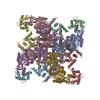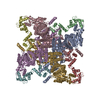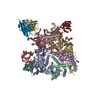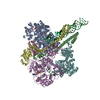登録情報 データベース : EMDB / ID : EMD-20294タイトル Single particle cryo-EM structure of the voltage-gated K+ channel Eag1 3-13 deletion mutant bound to calmodulin (conformation 2) Sharpened map for Eag1 3-13/CaM conformation 2 複合体 : Voltage-gated potassium channel Eag1 3-13 deletion mutant bound to calmodulin複合体 : Voltage-gated potassium channel Eag1 3-13 deletion mutantタンパク質・ペプチド : Potassium voltage-gated channel subfamily H member 1複合体 : calmodulin / / / 機能・相同性 分子機能 ドメイン・相同性 構成要素
/ / / / / / / / / / / / / / / / / / / / / / / / / / / / / / / / / / / / / / / / / / / / / / / / / / / / / / / / / / / / / / / / / / / / / / / / / / / / / / / / / / / / / / / / / / / / / / / / / / / / / / / / / / / / / / / / / / / / / / / / / / / / / / / / / / / / / / / / / / / / / / / / 生物種 Rattus norvegicus (ドブネズミ) / Homo sapiens (ヒト)手法 / / 解像度 : 4.0 Å Whicher JR / MacKinnon R 資金援助 Organization Grant number 国 National Institutes of Health/National Institute of General Medical Sciences (NIH/NIGMS) GM43949 Howard Hughes Medical Institute (HHMI) Damon Runyon Cancer Research Foundation DRG-2212-15
ジャーナル : Elife / 年 : 2019タイトル : Regulation of Eag1 gating by its intracellular domains.著者 : Jonathan R Whicher / Roderick MacKinnon / 要旨 : Voltage-gated potassium channels (Ks) are gated by transmembrane voltage sensors (VS) that move in response to changes in membrane voltage. K10.1 or Eag1 also has three intracellular domains: PAS, C- ... Voltage-gated potassium channels (Ks) are gated by transmembrane voltage sensors (VS) that move in response to changes in membrane voltage. K10.1 or Eag1 also has three intracellular domains: PAS, C-linker, and CNBHD. We demonstrate that the Eag1 intracellular domains are not required for voltage-dependent gating but likely interact with the VS to modulate gating. We identified specific interactions between the PAS, CNBHD, and VS that modulate voltage-dependent gating and provide evidence that VS movement destabilizes these interactions to promote channel opening. Additionally, mutation of these interactions renders Eag1 insensitive to calmodulin inhibition. The structure of the calmodulin insensitive mutant in a pre-open conformation suggests that channel opening may occur through a rotation of the intracellular domains and calmodulin may prevent this rotation by stabilizing interactions between the VS and intracellular domains. Intracellular domains likely play a similar modulatory role in voltage-dependent gating of the related K11-12 channels. 履歴 登録 2019年6月14日 - ヘッダ(付随情報) 公開 2019年9月18日 - マップ公開 2019年9月18日 - 更新 2024年3月20日 - 現状 2024年3月20日 処理サイト : RCSB / 状態 : 公開
すべて表示 表示を減らす
 データを開く
データを開く 基本情報
基本情報 マップデータ
マップデータ 試料
試料 キーワード
キーワード 機能・相同性情報
機能・相同性情報
 Homo sapiens (ヒト)
Homo sapiens (ヒト) データ登録者
データ登録者 米国, 3件
米国, 3件  引用
引用 ジャーナル: Elife / 年: 2019
ジャーナル: Elife / 年: 2019
 構造の表示
構造の表示 ムービービューア
ムービービューア SurfView
SurfView Molmil
Molmil Jmol/JSmol
Jmol/JSmol ダウンロードとリンク
ダウンロードとリンク emd_20294.map.gz
emd_20294.map.gz EMDBマップデータ形式
EMDBマップデータ形式 emd-20294-v30.xml
emd-20294-v30.xml emd-20294.xml
emd-20294.xml EMDBヘッダ
EMDBヘッダ emd_20294_fsc.xml
emd_20294_fsc.xml FSCデータファイル
FSCデータファイル emd_20294.png
emd_20294.png emd-20294.cif.gz
emd-20294.cif.gz emd_20294_additional.map.gz
emd_20294_additional.map.gz http://ftp.pdbj.org/pub/emdb/structures/EMD-20294
http://ftp.pdbj.org/pub/emdb/structures/EMD-20294 ftp://ftp.pdbj.org/pub/emdb/structures/EMD-20294
ftp://ftp.pdbj.org/pub/emdb/structures/EMD-20294 emd_20294_validation.pdf.gz
emd_20294_validation.pdf.gz EMDB検証レポート
EMDB検証レポート emd_20294_full_validation.pdf.gz
emd_20294_full_validation.pdf.gz emd_20294_validation.xml.gz
emd_20294_validation.xml.gz emd_20294_validation.cif.gz
emd_20294_validation.cif.gz https://ftp.pdbj.org/pub/emdb/validation_reports/EMD-20294
https://ftp.pdbj.org/pub/emdb/validation_reports/EMD-20294 ftp://ftp.pdbj.org/pub/emdb/validation_reports/EMD-20294
ftp://ftp.pdbj.org/pub/emdb/validation_reports/EMD-20294 リンク
リンク EMDB (EBI/PDBe) /
EMDB (EBI/PDBe) /  EMDataResource
EMDataResource マップ
マップ ダウンロード / ファイル: emd_20294.map.gz / 形式: CCP4 / 大きさ: 125 MB / タイプ: IMAGE STORED AS FLOATING POINT NUMBER (4 BYTES)
ダウンロード / ファイル: emd_20294.map.gz / 形式: CCP4 / 大きさ: 125 MB / タイプ: IMAGE STORED AS FLOATING POINT NUMBER (4 BYTES) 試料の構成要素
試料の構成要素
 Homo sapiens (ヒト)
Homo sapiens (ヒト)
 Homo sapiens (ヒト)
Homo sapiens (ヒト) Homo sapiens (ヒト)
Homo sapiens (ヒト) Homo sapiens (ヒト)
Homo sapiens (ヒト) 解析
解析 試料調製
試料調製 電子顕微鏡法
電子顕微鏡法 FIELD EMISSION GUN
FIELD EMISSION GUN
 ムービー
ムービー コントローラー
コントローラー









































 Z (Sec.)
Z (Sec.) Y (Row.)
Y (Row.) X (Col.)
X (Col.)































